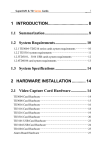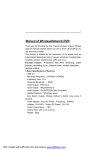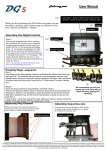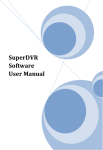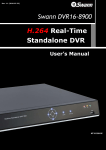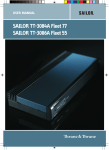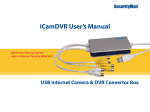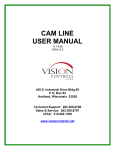Download MAXDVR & DR Series Cards
Transcript
MAXDVR & DR Series Cards 1 Please Note: This DVR software is for use with the 4 Channel USB DVR and also specific 1, 4, 8 and 16 channel DVR Cards. Not all software functions discussed below are available, applicable or supported by all hardware. The following are standard functions of the products: (1) Schedule record mode Users can choose any term in a day to record and set up record modes, i.e. sensor alarm record, motion detection record, manual record, Schedule Record. (2) Motion detection mode Motion detection areas are adjustable and maximum 16 areas for each channel. Users can also set motion detection sensitivity for each channel. The system begins to record only when motion of the detected object happens, and it will stop recording after a certain period, this function is adjustable by users. (3) Sensor alarm record mode With extra alarm board, the system enables alarm input and output. (4) Recycling record mode Users can set recording storage sequence for HDD partitions. The recording storage will automatically swap to the next partition when it is full. If all the partitions are full and recycling record mode is enabled, the former recorded data will be covered by new data. Users can also set HDD minimum storage alarm. Then once the present storage space is less then the minimum storage and recycling record mode is not enabled, the record will automatically stop. (5) P.T.Z control function Support a number of decoders. Users can control multiple speed domes and integrative cameras, including pan, tilt, zoom, focus and iris adjustment for P.T.Z devices. Support preset point and auto scout. (6) Users management MAXDVR & DR Series Cards 2 Different users have different rights,user names and passwords, so as to ensure system security. (7) Multi-channel display Support different multi-channel display modes, full screen display and auto dwell display. (8) Watch dog function The 16 Channels card has watchdog function. In case MAXDVR driver or windows system is frozen, the watchdog will restart the computer and login MAXDVR system again automatically. (9) One PC support 1 to 4 cards of the same model, the maximum frame rate can be 200 fps and 16 channels at most. (10) Support 320×240, 640×480 standard resolutions. (11) Image color adjustable for each channel, including contrast, lightness, hue and saturation. (12) MPEG4 compression format, greatly reduce HDD usage (13) Powerful video playback functions, including playback, pause, stop, fast-forward, single-frame play and image capture. (14) Support advanced search mode. Users can search by date/time, camera, record mode, and random combination of the three methods. (15) Support recorded files backup, delete by date/time, camera. (16) Convenient to extend system functions by software upgrade. (17) Supply multiple languages, including Chinese (Traditional), English, German, Spanish, Portuguese and other customized languages. (18) CPU and storage resources saving by advanced technology (19) Remote Surveillance and P.T.Z control through LAN, Intranet, and Internet. (20) Support alarm pre-record. (21) Support buzzer, email alarm out. (22) Can greatly decrease fragmented files while using NTFS partition. (23) User-friendly graphical user interface. MAXDVR & DR Series Cards 3 1.1 System Specifications Format: PAL/NTSC Resolution: DR3004F、3008F、3016F、3116、3216 support 320× 240 / 640×480 and DR5016F supports 352×288 / 352×240 Maximum Frame rate per channel: 25 fps (PAL), 30 ftp (NTSC) Screen set: resolution 1024×768, color quality 16 bits or 32 bits Compression code rate: 50kbps – 1.2Mbps Data format: MPEG4 1.2 Install Video Capture Card Driver Run Setup.exe, and the installation interface appears as below: Fig2.16 DR series video capture card installation interface MAXDVR & DR Series Cards Fig2.9 Welcome page 4 MAXDVR & DR Series Cards 5 Select ‘Next’, Fig2.10 Select video format Select ‘Next’, Fig2.11 Rate of progress of driver installation After this process it begins to install the application package MAX DVR, as below: MAXDVR & DR Series Cards Fig2.13 Select installation pass Select the suitable option, and click ‘Next’. Fig2.14 Register application Click ‘Next’, 6 MAXDVR & DR Series Cards 7 Fig2.15 Driver and application installation finished Click ‘Finish’ Now, after all the processes are finished, restart the computer and launch the surveillance program. It will create a shortcut on the desktop. Fig2.16 Shortcut of MAX DVR Notice: In case users cannot run the MAX DVR program, users have to restart the computer. 2 Main display Interface Run MAXDVR program and the main display interface appear as below: MAXDVR & DR Series Cards 8 Fig3.1 MAXDVR Main Display Interface 2.1 Display Control Panel Display Control Panel Fig3.2 Display control panel ‘Display control panel’ includes ‘Display Mode’ buttons and disk free space indicator, ‘Auto Dwell’ button, 1, 4, 6, 8, 9, 13, 16channels display buttons. Every button has its built-in indicator light. When switch on and off the buttons, the relative indicator lights turn on and off to indicate the working 9 MAXDVR & DR Series Cards status. Notice: Users can judge which buttons are working by the color of the buttons. Free space Display Modes 1CH 4CH 6CH 8CH 9CH 13CH 16CH Fig3.3 Display Modes Panel Flip Pages When the display mode is 1CH, 4CH, 6CH, 8CH, 9CH or 13CH, click , system will display the next page according to the display mode. Auto Dwell display Mode In case users want to see all the channels in sequence, then click and enter Auto Dwell display mode. Quick Switch In case the present display mode is 4CH, 9CH or 16CH, by clicking any image or the present display mode is 6CH, 8CH or 13CH, by clicking the bigger image, the display will quickly switch to corresponding single channel display mode. When the present display mode is 6CH, 8CH or 13CH, by clicking any image other than the bigger one, users can change the position of the image with the bigger one. By clicking the single image again, it will return to the former display mode. 10 MAXDVR & DR Series Cards 2.2 Login Click , and login window appears. Input the user name and password, the default user name is ‘SYSTEM’ with no password, users can access to the main interface. Users can change password for SYSTEM and create new user names and passwords once has entered the system. Time & Date Login Search and Playback Configuration PTZ Control Exit Display Mode Panel Alarm out status Camera status Fig3.4 Main Interface 2.3 Record Record Modes According to different record triggering methods, DR series video capture cards offer users with 4 kinds of record modes: (1) Schedule record mode (timer) MAXDVR & DR Series Cards (2) Manual record mode (3) Motion Detection record mode (4) Sensor Alarm record mode 11 Motion Detection record mode and Sensor Alarm record mode are together called as Alarm Record. Multiple cameras record In case users use multiple cameras to record, every camera works separately and the record file are also saved separately. The parameters, i.e. camera ID, record date/time and record mode are all saved together with the record file. Record Setup Fig3.5 Record Configuration Panel In the ‘Record Panel’ of the Basic Configuration page, users can set all kinds of necessary parameters for recording. [Time stamp]: By selecting the options, the record date / time message appears in the record file images. [Switch]: By selecting the options, users can turn on corresponding cameras. In case there is no camera for some channel, don’t select the option so as to save system resource. [Manual record]: By selecting the options, the relative camera images will be recorded and saved all the time. [Manual recording frame rate]: Select the record frame rate for manual MAXDVR & DR Series Cards 12 record mode [Schedule Record]: Schedule record option. [Schedule Record Frame Rate]: Select Schedule Record frame rate [Motion Detection]: By selecting the options, users can set relative channels’ record mode as motion detection [Motion Record Frame Rate]: Select record frame rate for Motion Detection record mode [Sensor Record Frame Rate]: If sensors are utilized to trigger recording, users can select record frame rate here. [Camera Security]: The users are divided into three standards: Normal user, Power user and Administrator. By selecting the options, only administrators can see the corresponding channels. [Record Quality]: Select record image quality here. [Audio In]: MAXDVR 4.3 system can support one channel of microphone audio input signal on the PC motherboard and audio inputs on the card if it has. Users can choose one video channel associate these audio signals. Note: Users can select more than one record mode. Record Status Panel Fig3.6 Record Status Panel and Alarm Output Status Panel Meanings of indicator light colors in row one are as below: (1) Normal State 13 MAXDVR & DR Series Cards (2) Manual Record State (3) Schedule Record State (4) Motion Detection Record State (5) Sensor Alarm Record State (6) Video Loss State When the indicator light color turns into in row two, it means there is alarm output. Manual Record Mode Manual Record mode is the most commonly used record mode. In case there is any special event happens, users can select this record mode and record timely. Note: You can select high frame rate for short time manual record, while select low frame rate for long time Schedule Record. Sensor Alarm Record Mode Users can use sensors to trigger sensor alarm record for relative channels. At that time, the record status indicator light will turn red . Motion Detection Record Mode It will enable the system to detect image changes and begin to record by activating motion detection and motion alarm record. For instance, somebody opens the door, and the system detects image changes and begins to record, then users can play back the recorded file and find out who opened door. 14 MAXDVR & DR Series Cards When there is no movement, the system won’t record and that’s helpful for saving system resource, and convenient for searching for event record file. The indicator light color in the record status panel is yellow . Note: Users may need to setup in three places so as to enable motion detection record. (1) Select ‘Motion Detection’ for certain channels in ‘Basic Configuration’ (2) Configure the motion detection areas for certain channels in ‘Motion Detection configuration’ (3) Configure working schedule for certain channels in ‘Schedule configuration’ Schedule Record Users can set working schedule for all kinds of record modes in ‘Schedule configuration’. The green light in record status panel shows the corresponding channel is in Schedule Record mode. Users can change record mode to manual record at any time, and the green light change into blue light will . Please refer to chapter 4.4 for details. Recycling Record If users enable Recycling Record function and all the selected HDD partitions are full, the former record data will be covered by the latest record data. Users can set recording storage sequence for HDD partitions. The recording storage will automatically jump to the next partition when it’s full. If MAXDVR & DR Series Cards 15 all the partitions are full and recycling record mode has been enabled, the new data will overwrite the former recorded data automatically. Users can also set HDD minimum storage alarm. Then once the present storage space is less then the minimum storage and recycling record mode hasn’t been enabled, the record will automatically stop. 3 System Setup Click and enter the main setup interface. Fig4.1 Basic Configuration The definitions of the buttons in Fig4.1 are as below: MAXDVR & DR Series Cards 16 Basic Configuration Schedule configuration Video configuration Motion Detection Configuration Alarm Configuration P.T.Z Configuration User Configuration Return 3.1 Basic Configuration Click and enter the basic configuration page where users can MAXDVR & DR Series Cards 17 setup the system or just use the defaults. Fig4.2 Caption and General Configuration [Dwell Interval.]: If users enable Auto Dwell function in the main interface page, users can set the dwell time of a page here. [Caption]: There are four options, None, ID, Name and ID/Name for users to select for all the channels. ‘None’ means no title; ‘ID’ means camera numbers, i.e. 1, 2, 3 and so on ‘Name’ means camera names, i.e. Cam1, Cam2 and so on ‘ID/Name’ means both camera number and camera name, i.e. 1/Cam1, 2/Cam2 and so on [Resolution]: There are four options,320×240、352×288、352×240、640× 480 for users to select for all the channels. As the video may have interlace lines if the users select 640x480, users may choose for solve this problem, but it will occupy much more CPU loading. [Call Monitor] Only DR3016F, DR3216 and DR5016F have call monitor function at present. Users can connect another monitor to the card and select the display modes here. The following is about record data storage. Please check Fig4.3 MAXDVR & DR Series Cards 18 Fig4.3 Record data storage precept Above, MAXDVR system shows all the available HDD partitions for users. Users can select one or more of the partitions that will be used in sequence from up to bottom. Please refer to chapter 3.3.8 to learn more about recycling record. In the following area in the basic configuration page, users can input the computer user name and password in the relative boxes. Then when restarting the computer system, it will access to the system with the user name and password input in the boxes. Fig4.4 Computer System Reboot setups As the windows system may become unstable after a couple of days continue operating, which will cause MAXDVR system unstable? Then users MAXDVR & DR Series Cards should reboot the computer. Select 19 and set the interval by day, which will guide the system to reboot automatically according to the setups. Click to return to the main display interface. 3.2 Video Configuration Click and enter the video configuration page as below. Users can change the values of corresponding items, i.e. contrast, brightness, hue, saturation, auto gain, by drawing the levers on the bars. Click ‘Default’, and all the values will return to the default value. Fig4.5 Video Configuration Definitions of the setup items: MAXDVR & DR Series Cards 20 [Contrast]: set image color contrast [Brightness]: set image brightness [Hue]: set image hue [Saturation]: set image Saturation [Auto Gain]: users can set it as auto or manual. Only 4CH Card and 16CH card have this function(except DR5016F because of only having manual gain function). [Default]: load defaults, i.e. set the first four items value as 5000 and the last item value as 0. 3.3 Motion Detection configuration Click and enter Motion Detection Configuration page, DR3004F, DR3008F, DR3016F, DR3116, DR3216 as below: Fig4.6 Motion Detection Configuration Definition of the setup items: MAXDVR & DR Series Cards 21 [Sensitivity]: users can set motion detection sensitivity here. [Select all]: select all the areas of the channel as detection area [Clear]: clear all the detection areas and then users can select customized detection areas by cursor. DR5016F: Fig4.7 DR5016F’s configuration page [Speed]: motion detection sensitivity. [Block Number]: set grid’s number. [Defaults]: set as default. MAXDVR & DR Series Cards 22 Set Motion Detection Area In case users want to customize the detection areas for a certain channel, first select the camera, then select ‘Clear’ and drag the cursor in the box on the left side. Now, users can see a green box appears which shows the motion detection area. Users can select maximum 16 customized areas for each channel. By click ‘Clear’, users can clear all the selected areas. Set Motion Detection Sensitivity Draw the bar and select a certain value for motion detection sensitivity. 3.4 Schedule configuration Click and enter Schedule Configuration page as below: Fig4.8 Schedule Configuration Our DR series system offers the users with powerful schedule MAXDVR & DR Series Cards 23 configuration options. Every channel has three kinds of record modes, i.e. schedule record, motion detection record and sensor alarm record. We provide users to set schedules from Sunday to Monday separately for all of the three record modes. Sensor alarm record mode has the highest priority among all record modes. Here users can set schedules for it. When users need to edit schedule for a channel, first select the camera name in the three record modes group, and select the color bars on the right side, then select ‘Edit’ to edit schedules. Click ‘Add’ to add schedule for a certain channel. Note: the added schedule should not be reduplicate to the former settings. Click ‘Delete’ to delete schedule. Click ‘Clear All’ to delete all the schedules of a certain channel. See the Fig4.8 and learn how to edit schedules for a channel: Fig 4.9 Edit Schedule 3.5 Motion Detection Alarm Configuration Alarm Triggering Conditions Configuration The system can receive alarm both from local place and network (1) Local place alarm record triggering conditions configuration MAXDVR & DR Series Cards 24 Fig 4.10 Local place alarm triggering conditions configuration Relative Explanations: [Buzzer]: Users can select whether to open the computer buzzer if the alarms have been triggered and also select how long the buzzer rings [PreRecord]: Users can select whether to enable alarm pre-record and also pre-record time. [Motion Holding Time]: Motion sensor may detect some movement, only if the movement lasts for a period exceeding the default time, then the alarm record will begin and buzzer beeps. [Disk Shortage Alarm]: If the HDD available space is less then the set value, the buzzer will beep if ‘Buzzer’ has been selected. (2) Alarm output terminal in LAN Fig 4.11 Alarm output terminal in LAN Select ‘Remote Alarm’, and enter the area as Fig4.10 shows. MAXDVR & DR Series Cards 25 Click ‘Add’ to add alarm output terminals in LAN. Look the figure below: Fig 4.12 Add alarm output terminal in LAN Find the terminal computer and click ‘OK’, and users can see the name of the selected terminal will appear in the box as below: Fig4.13 List of alarm output LAN terminals Note: this function is only valid in LAN, not in Internet. MAXDVR & DR Series Cards 26 Alarm Record Fig4.14 Alarm trigger method configuration Every sensor can trigger multiple channels to record. For example, if users select CAM1, CAM4 and CAM5 for Sensor2, then once the sensor is activated, CAM1, CAM4 and CAM5 will begin to record. Users can also select the voltage, high and low, for alarm signals. MAXDVR & DR Series Cards 27 Alarm Output Fig4.15 Alarm output Configuration [Video Loss]: Users can select alarm output for this option. For example, users select alarm_out1 and alarm_out3 and remote alarm for video loss. Then video loss of any channel will trigger alarm_out1, alarm_out3 to show red light in the Alarm output status panel (refer to Fig3.6 for reference), and the system will give out related warning message to the terminals in List of alarm output LAN terminals (refer to Fig 4.12) [Disk Alarm]: when HDD available space is less than the set value (refer to Fig4.9), it will trigger selected alarms. [Sensor 1]: If users have mounted sensors, when the sensors have been activated, then it will trigger the selected output alarms. [Sensor 2] – [sensor 16] DR3004F card has maximum 4 sensors, and DR3016F and DR3116 card have maximum 16 sensors. [Motion 1]: Users can set motion detection alarm output by different alarms and remote alarm. [Motion 2] - [Motion 16] 4CH card has maximum 4 motion alarms, 8CH MAXDVR & DR Series Cards 28 card has maximum 8 motion alarms, and 16CH card has maximum 16 motion alarms. Notes:You should choose our additional alarm device board while using DR3008F, DR3216 cards for alarm I/O. Auto Mail Function Press in the main interface and access to the following Alarm Configuration area where users can make motion detection alarm setup, sensor alarm setup and short of HDD space alarm setup. Now users can select the above-mentioned alarms to be output by Auto Mail. Fig 4.16 Alarm output configuration Click ‘Auto mail’ icon on the top left side and enter the following area to make Auto Mail setup: 29 MAXDVR & DR Series Cards Fig 4.17 AutoMail setup interface In this area, users can set receiver and sender’s E-mail SMTP server and address. Note: the address of receiver and sender can be the same. Receiver’s E-mail Address Sender’s E-mail Address Sender’s SMTP Server Fig4.18 Auto Mail Setup E-mail Subject Sender’s Password Sender User Name 30 MAXDVR & DR Series Cards To test the settings, click ‘Send Mail Test’. If all settings are okay, message ‘Message Sent Successfully’ will pop up. If some settings are wrong, there will a pop-up window warning message. Enable ‘Attachment’, then the present image when an alarm is triggered will be sent to appointed mailbox. Channel Name Display Time Image format Resolution Fig 4.19 Attachment Setup Note: for every alarm event, only one picture will be sent. Users can input a short message about the Auto Mail in advanced, so the receiver will know what happened. 31 MAXDVR & DR Series Cards 3.6 P.T.Z Control Configuration Click and enter the following area: Fig4.20 PTZ configuration panel Protocol Setup Users can select different protocols, serial port number for P.T.Z devices. Select Camera Select PTZ Protocol Select Select Protocol COM PTZ Address Fig4.21 P.T.Z protocol setup MAXDVR & DR Series Cards 32 Relative Definitions: [Port]: users can set serial port number [Protocol]: P.T.Z device communication protocol [Address]: P.T.Z device communication address Serial ports setup Users should firstly enable the P.T.Z control function of a certain camera and select a port number in P.T.Z Protocol Setup (refer to Fig4.22), and then set corresponding parameters in the area below: Fig4.22 P.T.Z serial port setup Relative explain: [Port]: users can set port number [Baud Rate]: set P.T.Z device Baud Rate, default value is 9600 [Data bits]: default value is 8 [Parity]: odd and even parity bit, default Null [Stop Bits]: default value is 1 Notice: Users should look into the P.T.Z device and get the Baud Rate, MAXDVR & DR Series Cards 33 Protocol, and Address first, then set their values accordingly. 3.7 Users Configuration Click and access the following area: Fig4.23 User configuration After installing the MAXDVR system, it will automatically create an administrator user of which user name is SYSTEM with no password. Users can use this user name to log in the system and ‘Add’, ‘Edit’ and/or ‘Delete’ users’ parameters. Change User rights Select a user in User Configuration area (refer to Fig4.23), and click ‘Edit’ and enter Edit User area, as below: MAXDVR & DR Series Cards 34 Fig4.24 User password and rights edit Users can edit user’s password and rights here, but not the user name. Note: The system offers three kinds of rights: Administrator: this kind of user of the highest rights to change all the settings and playback. Power user: this kind of user cannot access Basic Configuration and change settings, but has all the other rights of Administrator. Normal: this kind of user can only access MAXDVR main display interface (refer to Fig3.1) Notice: Administrators can change Power users and Normal users’ rights, but can’t change other administrators’ rights. Add User Click ‘Add’ in User Configuration (refer to Fig4.25), and access the following area: MAXDVR & DR Series Cards 35 Fig4.25 Add user Input user name, password, confirm password and select user rights, and then click ’OK’. Delete User Select the user name in User Configuration (refer to Fig4.26), and click ‘Delete’, and confirm delete. See below: Fig4.26 Confirm delete user 4 P.T.Z control Click in the MAXDVR main display interface (refer to Fig3.1) and access to the following area: 36 MAXDVR & DR Series Cards Fig5.1 P.T.Z control interface Users can control P.T.Z devices by the function buttons on the right side, see as below: Goto Preset Point Preset and Group Set PTZ Speed PAN and Tilt Focus Zoom In/Out Iris MAXDVR & DR Series Cards 37 Fig5.2 P.T.Z Control function buttons panel In the upper circle, there are five function buttons, i.e. upward button, downward button, leftward button, rightward button and stop button. The other buttons are Focus buttons (+ and -), Zoom buttons (+ and -), Iris buttons (+ and -). Click and to increase and decrease the corresponding values. When users need to utilize P.T.Z control, first enter P.T.Z Control Interface (refer to Fig5.1), and click the corresponding channel (users can see a red fringe around the channel), then users can begin to control the enabled P.T.Z control camera. Notice: After pressing left mouse button on any function button in P.T.Z Control Function Buttons Panel (refer to Fig5.2), PTZ device starts moving, when user releases it, PTZ device stops moving. Fig 5.3 Speed adjustment Users can select different Pan speed, Tilt speed, Focus speed and Zoom speed for P.T.Z devices. [Pan Speed]: set horizontal rotating speed [Tilt Speed]: set vertical rotating speed [Focus Speed]: set camera focus speed [Zoom Speed]: set zoom in/ zoom out speed MAXDVR & DR Series Cards Click 38 and a pop-up window will appear, users can choose different preset or group set. Fig 5.4 Preset and group select Click to set Preset point and change Preset point name. Every Group includes multiple Preset points. In case users select preset1, preset2 and preset3 for group1, preset1, preset2 and preset3 will be automatically accessed in sequence after users select group1 for auto scout. MAXDVR & DR Series Cards 39 Fig 5.5 Preset Click , a pop-pup window as following will appear: [Dwell]: users can set the dwell time of a page here. MAXDVR & DR Series Cards 40 Fig 5.6 Group configuration 5 Record Search and Playback Click in the MAXDVR Main Display Interface (refer to Fig3.1) and access to the following area: Fig6.1 Search and playback Interface This interface is divided into 4 parts, i.e. record search area, record playback area, record play area and other functions areas. Press and return to the live surveillance status. 41 MAXDVR & DR Series Cards 5.1 Record Search Search By Date Record Time Display Search Original Files Search Backup Files Search Manual Manual Record Events Search Schedule Record Events Search Motion Detection Events Search Sensor Alarm Events Fig6.2 Record search area A, B and C marks the areas of three search methods. st A: Search by date (range from Jan 1 , 1971 till now) B: Search in backup file and original file C: Search by record mode. This is useful when user wants to look through some important events. Users can select one or above of the three searching methods to search for needed record file. MAXDVR & DR Series Cards 42 5.2 Record Playback and Control Fig6.3 Record playback and control Explain of the button function: : Play / Pause : Stop : Play backwards. This button is valid when playing back by single channel : Previous Section. This button is valid when playing back by single MAXDVR & DR Series Cards 43 channel : Next Section. This button is valid when playing back by single channel : Previous Frame. This button is valid when playing back by single channel playback pause mode : Next Frame. This button is valid when playing back by single channel playback pause mode Users can select suitable play speed in the area as below: Fig6.4 Play Speed Controller The following area shows the record files of different channels: Fig6.5 Record Files Browser The upper bar shows the hours in a whole day. Click the bar, and it will be magnified 10 times, therefore users can see the detailed time marks. When searching for a certain section of the file, users can draw the scrolling-bar to the area that most likely contains the needed section. If necessary, click the bar once and see the magnified time marks for precise search. The left side shows the available channels. When a certain channel has been selected for playback, the background color will be highlighted, or it’s dark gray, and a tick sign will appear beside the channel title. 44 MAXDVR & DR Series Cards The main area at the center gives details of the record files. Different colors of the bar show different kinds of record modes of the files. The following are the definitions of the color bars: Manual Record Events Schedule Record Events Motion Detection Record Events Sensor Alarm Record Events Click to play selected record files. The system offers 1Ch, 4CH, 9CH and 16CH playback modes. The following is multiple channels playback control area: Fig6.6 Multiple Channels Playback Control The system default playback mode is one channel. That’s Camera1. In case users need to change to other channels, then click and the following channel configuration window will appear, as below: Fig6.7 Channel Configuration Window for 1 Channel Playback Mode Note: Take 16CH card for example. But in fact, 4 pieces of 4CH cards can make the same effect. Users can select one channel from all the available channels for playback. MAXDVR & DR Series Cards 45 In case user needs to play back 4 channels at the same time, then click , and the following channel configuration window will appear, as below: Fig6.8 Channel configuration dialog for 4-channel playback mode Users can select any four channels from all the available channels for playback. The system offers quick select methods for users. For example: by selecting ‘Third 4 Channels’ Camera9, Camera10, Camera11, and Camera12 will be selected simultaneously. In case user needs to play back 9 channels at the same time, then click , and the following channel configuration window will appear, as below: Fig6.9 Channel configuration window for 9-channel playback mode Users can select any 9 channels from all the available channels for MAXDVR & DR Series Cards 46 playback. Users can also use the quick select methods by the system. In case user needs to play back 16 channels at the same time, then click , and the following channel configuration window will appear, as below: Fig6.10 channel configuration window for 16-channel playback mode Then click ‘OK’ to play back. Tips: Click any channel and magnify it to see the single channel. Click again to return to the former playback mode. 5.3 Other Functions Record File Backup Click and enter the following menu: MAXDVR & DR Series Cards 47 Fig6.11 Recorded files backup Users can select corresponding cameras and copy the record files to another path in this area. This is the file backup function of the system. The interface is divided into four areas: A: Camera Selection Area B: Time and Date Selection Area C: Operation Area D: Information Area In A area, users can select one or more cameras; In B area, users can set start time/date and end time/date, and then backup the files recorded by channels selected in A area by the time interval; In C area, users can set backup path Click ‘Start’ to backup files. Delete Record Files Click and the following window will appear: MAXDVR & DR Series Cards 48 Fig6.12 Delete recorded files Users first select the channel on the left side, and then select start time/date and end time/date of the record files, click ‘Start’ to delete files. Capture Pictures The definitions of the function buttons are as below: : Capture picture : Print setup : Print captured picture Notice: Only in one channel playback pause mode (refer to Fig6.1) this function is valid. When in single channel playback pause mode, automatically the following color control panel (Fig6.12) will appear, by which user can make 49 MAXDVR & DR Series Cards color rectification for the present channel, including brightness, contrast, saturation and hue, and press ‘Default’ to recover to the original settings. Fig6.13 Color control panel When in the single channel playback pause mode, click and the following window will appear as below: Fig6.14 Capture multiple images in sequence Select path and click ‘Save’ to save the picture. User can also print the images that have been captured. MAXDVR & DR Series Cards Click and make corresponding print setup as below: Fig6.15 Print setup Click users can have print preview as below: 50 51 MAXDVR & DR Series Cards Fig6.16 Print preview Select and then click or picture upward, downward, leftward and rightward. Select click to move the and then to zoom in and out the image. Press , return to the original settings. Press ‘Print’ in the print preview window, users can print the image directly. Image Zoom In / Out When in single channel playback state, the zoom control icons will appear. Select and click on the channel will zoom out the image. By clicking continuously, the image will be zoomed out continuously. Select effect. Click and do the some operations to get the opposite and recover the original size. Take the following three pictures for example, MAXDVR & DR Series Cards Fig6.17 Example: original size 52 MAXDVR & DR Series Cards 53 Fig6.18 Example: zoomed out Fig6.19 Example: zoomed in 6 Remote Surveillance and Playback 6.1 Remote Live Surveillance Our DR series surveillance system supports Remote Surveillance through LAN, Internet and Intranet. Simply enable web cam function of the system on a computer which is connected to Internet, and the computer system will become an Internet web cam server. On any other computer that connects to Internet or the same LAN network, input the MAXDVR server address in IE browser, the end users can get high quality real time image from MAXDVR & DR Series Cards 54 the server and also control the P.T.Z devices. Remote Surveillance Server Configuration Users should firstly enable the Web Camera Services in Basic Configuration (refer to Fig4.1) and set other settings as below: Fig7.1 Web cam server configuration [HTTP Port]: Web service & download service port, default value is 80 [Data Port]: data transmission port, default value is 1159 [Command Port]: control command port, default value is 1259 [Picture Quality]: default value is higher Remote Surveillance Client-side Setup On the client-side, users should firstly install the WebCam program. And the following is the detailed information. Input the WebCam server IP address in Internet Explorer and the following page appears: MAXDVR & DR Series Cards 55 Fig7.2 Remote surveillance and playback services selection [Live Surveillance]: this option is for users to see remote live view. [Remote Playback]: this option is for users to play back recorded files. Notice: In case the HTTP port setting is not 80 (80 is the default setting, commonly use) and when input the server IP address, users should add the port number after the IP address. For example, the server IP address is 211.148.96.234, and the port number is 81, then users should input http://211.148.96.234:81 . Select Live Surveillance, and click ‘OK’ to install Remote Surveillance client-side program as below. In the next chapter, we will learn more about Remote Playback. When connecting to the server for the first time, then the following window will pop up: MAXDVR & DR Series Cards 56 Fig7.3 Inquiry for installing WebCam downloading component Notice: If users have already installed client-side program before and MAXDVR version has not been changed on the server, after inputting server address in IE browser, Fig7.9 will come out without downloading or installing WebCam. MAXDVR & DR Series Cards 57 Fig7.4 WebCam client-side driver initializing After initialization has been completed, WebCam will be installed automatically. MAXDVR & DR Series Cards Fig7.5 WebCam installation Fig7.6 Default install path Users can choose path by clicking ‘Browse’. Click ‘Next’ to continue: 58 MAXDVR & DR Series Cards 59 Fig7.7 Register program folder name Click ‘Next’ after input the folder name or select the default name, and then ‘Finish’ installation as below: Fig7.8 Installation success Then the WebCam main interface will appear as below: MAXDVR & DR Series Cards 60 Fig7.9 WebCam main interface Click and input user name and password, as below: Fig7.10 Login webcam Click ‘Options’ and enter the advanced setting area. Users can modify default Server IP, Data Port and Command Port . Note: The default User name is SYSTEM without password. Users can set user name and password at the server end (refer to Fig4.23). MAXDVR & DR Series Cards 61 After logging into server, you will get the first channel video from server, and you can adjust screen mode just like MAXDVR, the bellow is the WebCam surveillance mode interface. Fig7.11 WebCam surveillance state Alarm state monitor and PTZ control are all same as MAXDVR, we would not need to give detail explanation here. 6.2 Remote Playback Remote Playback server Configuration For using our powerful remote playback function, users should first enable Web Cam service and Remote Playback Service in Basic Configuration (refer to Fig4.1 and Fig7.12). MAXDVR & DR Series Cards 62 Fig7.12 Remote playback service configuration [RPB Port]: the default value is 13551 Note: Uses can enable remote playback service without running the MAXDVR. Just enter the installation folder of MAXDVR, and activate MediaServer, users can also enable the RPB service. Once the remote playback service has been enabled, there will be an icon on the taskbar to remind users the service has been activated. Fig7.13 Remote playback service activated Remote Playback Client-side Setup Users should also first download and install playback program. This chapter will guide users how to make it. Input server address in IE browser, and the following interface appears: MAXDVR & DR Series Cards Fig7.14 Remote surveillance and playback services selection Select ‘Remote playback’ and click ‘OK’, 63 MAXDVR & DR Series Cards 64 Fig7.15 installing remote playback program Notice: In case users have already installed the remote playback program before and MAXDVR version has not been changed, there is no need to download and install it again, it will go to Fig7.20 directly. After initialization has been completed, users need to install the program. First select installation path as below: Fig7.16 Default install path Users can set another path by clicking ‘Browse’. Click ‘Next’ to continue: MAXDVR & DR Series Cards 65 Fig7.17 Register program folder name Click ‘Next’ after inputting the folder name or selecting the default name, then the following figure appears: Fig7.18 Playback program installation process rate MAXDVR & DR Series Cards And then click ‘Finish’ to finish installation as below: Fig7.19 Installation success Then the playback client-side main interface will appear as below: Fig7.20 Remote playback client-side main interface Corresponding Explanations: 66 MAXDVR & DR Series Cards 67 : Log in : Minimum : Setup : Exit : Play : Pause : Begin / Stop record : Slow down playing speed : Accelerate playing speed : Play at the original speed Remote Playback Configuration and Control 6.2.1.1 Setup Before logging in the server, first click corresponding settings, and make 68 MAXDVR & DR Series Cards IP address Port No. Record file save path Fig7.21 Client-side configuration 6.2.1.2 Log in Remote Playback System Click after making up certain configurations, and the following window appears. Fig7.22 Login remote playback system Input the right user name and password and enter the remote playback main interface as below: Note: The default User name is SYSTEM with no password. Users can set user name and password at the server end (refer to Fig4.23). MAXDVR & DR Series Cards 69 Fig7.23 Remote playback main interface 6.2.1.3 Control playback Select the time period for playback Once login the system, the setup button and login button are disabled. Click and the following window appear. MAXDVR & DR Series Cards 70 Fig7.24 Select date/time period for playback Select the date / time, then click ‘OK’ to save the setting and return to the main interface. Click ‘Cancel’ to give up setting. The selected time / date will appear at the left bottom of the screen. Play Control Click and begin to play the recorded files. Press to pause. Users can draw the lever as below to select time to play. Fig7.25 Time control Lever The following area is for users to control the play speed. Fig7.26 Play speed control module Remote Record Click to and begin to record remotely. And the icon changes . Click it again and stop recording. Users can select save path and compression format before logging in the system. MAXDVR & DR Series Cards 71 6.3 Mobile Surveillance Introduction to Mobile Surveillance In SuperDVR system, the mobile surveillance can be realized by connecting the mobile phone to the system. For time being, the function is supported by Windows Mobile system and Symbian Series 60 Developer Platform 2.0 intelligent mobile phone system. So far, the types of phones on which the function has been tested include mini 02, Xda II, Xda Atom, pocket PC phone edition, dopod 696, dopod 900, dopod 838, which are based on Windows Mobile system, and Nokia 6260, Nokia N70, Nokia 3230, Nokia6680 based on Smybian Series 60 system. Client Configuration of Windows Mobile Server configuration on MAXDVR needs to be set before the function on phone is activated. Please refer to Section 7.1 “Remote Live Surveillance”. Firstly activate the network access on mobile phone and then run “Internet Explorer” after the server configuration has been done. Input the server’s address and the connection is built up shown as below: Figure7.27 connected to the server Click “PCam v1.0.6.5291”. A dialog box pops up: MAXDVR & DR Series Cards 72 Figure7.28 downloading dialog box Please click “Yea” to start installing: Figure7.29 downloading status information PCam will be opened after the download is finished: Figure7.30 Main layout of PCam Input the server’s address, user name and password respectively in the columns MAXDVR & DR Series Cards 73 of “Server”, “User” and “Password” and click “Go” to log on the server. Successful log on information appears if the server address, user name and password are all correct. Figure7.31 Log on system successfully Channel one is the default displaying channel after log on successfully. Changing channel can be approached by selecting the channel in rolling-down menu of “Channel”: Figure7.32 selecting channel Click “Stop” to disconnect the communication with the server. Client Configuration of Symbian 60 Server configuration on MAXDVR needs to be set before the function on phone MAXDVR & DR Series Cards 74 is activated. Please refer to Section 7.1 “Remote Live Surveillance”. Firstly enable the network access on mobile phone and then run Web browser after the server configuration has been done. Input the server’s address and then the connection is built up shown as below: Figure7.33 Open Web Browser Input the server address in a new-built bookmark. Click this bookmark to connect to the server. Figure7.34 Build a bookmark Figure7.35 Connect to the server MAXDVR & DR Series Cards 75 Click “install package” to start downloading and a confirmation information window pops up after downloading is finished. Figure7.36 Confirmation Information window System reminds of whether to install the “SCam” if clicking “Yes”: Figure7.37 Installing information Click “Yes” to start installing. A Scam shortcut icon appears on the desktop after the installation has been done. Figure7.38 Scam shortcut icon in system menu Run “Scam” by clicking the icon: MAXDVR & DR Series Cards Figure7.39 Main layout of Scam Enter the main menu by clicking “Options”, Figure7.40 Main menu of Scam Click “Setting” to set the log-in information, Figure7.41Configure log-in information Click “Login” to build up the communication with server, 76 MAXDVR & DR Series Cards Figure7.42 Connecting to the server Figure7.43 Log on successfully 77 MAXDVR & DR Series Cards 78 Appendix Appendix 2: Frequently Asked Questions Appendix 2.2 How to Use MAXDVR Appendix 2.2.1 Meanings of the indicator lights Grey- Normal state Red—Sensor alarm Yellow- Motion detection alarm Blue-Video loss Bottle Green- Manual record state Reseda- Schedule record state Note: Users can refer to Fig3.6 to learn more. Appendix 2.2.2 How does the different record format work? Users can set more than one record modes in Record setup (refer to Fig3.5), but actually, there is only one valid record mode for recording. The priority order of the record modes is: Sensor Alarm Record > Motion Detection Record > Manual Record > Schedule Record Appendix 2.2.3 How to set recycling record mode on the system? Select ‘Recycle’ in basic configuration, refer to Fig4.1. Users can select multiple HDD partitions to save record files. It won’t cover former files until all the partitions’ available storage spaces are less than MAXDVR & DR Series Cards 79 100MB. In case users haven’t enabled recycling record mode and the partitions’ storage spaces are less than 100MB, the alarm will ring and the HDD usage indicator will turn red. Tips: It is recommended that install MAXDVR into the partition installed with windows system (normally C:), and save record files in HDD partition D: Appendix 2.2.4 How to set auto reboot function? In case Microsoft Windows system continuously runs for a couple of days, the system may become unstable, therefore it’s suggested to restart the computer every few of days. In the basic configuration (refer to Fig4.1), input Windows user name and password (Note: not MAXDVR user name and password), and select time interval, then the Windows system will automatically restart according to the set time. In case the Windows system closed abnormally, i.e. power supply is cut off, and when computer reboot next time, MAXDVR system will automatically restart, and keep the settings as before. Tips: Users do not need enable auto reboot function, but it’s suggested to input the Windows user name and password in the relative area, therefore when meeting abnormal system exit, users don’t need to input Windows and MAXDVR user names and passwords. Appendix 2.2.5 How to quickly use the schedule record function? Press ‘Shift’ or ‘Ctrl’ key, and draw the cursor in corresponding areas to make schedules for multiple channels. MAXDVR & DR Series Cards 80 Appendix 2.2.6 What are the byte rates for different image qualities from highest to normal? When on PAL system and the frame rate is 25 fps, bit rate for the highest image quality is about 120K Byte/s, and for the lowest image quality is about 30K Byte/s. Appendix 2.2.7 The frame rate seems to be lower than what I set? There is frame loss in image switch therefore the real record frame rate is about relatively lower than the theoretic value. Appendix 2.2.8 Why I can’t select more channels to backup? Please draw the mouse in the channel selection area, or utilize Shift and Ctrl key for assistance. Appendix 2.2.9 When should I select manual Gain Control? In case the video signal is seriously decreasing, and the color images turn to black and white, use manual gain control may be helpful. Appendix 2.3 How to Use Network Function Appendix 2.3.1 How to monitor on the client-side? First enable ‘Web cameras service’ in basic configuration (refer to Fig4.1). Input the server Internet address in IE browser on the client-side, and the necessary web cam driver will be downloaded automatically, then users need to install the driver. After access the web cam main interface, click ‘login’ and input user name and password to log in the system. (Refer to Chapter 7 to MAXDVR & DR Series Cards 81 learn more) Appendix 2.3.2 Why I can’t download the client-side software? The possible causes: The client-side computer hasn’t properly connected to Internet or LAN. The server-end hasn’t enabled ‘web cameras service’ The default Http port is 80. It may conflict with other Web servers, for example IIS. If true, please change another port. Windows XP SP2 will block the OCX download. You should enable ‘Internet Option Security Settings Download unsigned ActiveX controls’. Appendix 2.3.3 Why can’t the server be configured at the client-side? The possible causes: It cannot be configured at the client-side, when the server is being configured at the server-end. Only the last configuration is valid if server different configuration are deployed simultaneously. Appendix 2.3.4 Why I can’t see the images? The possible causes: The VGA card is too out dated. Have not installed newer DirecDRraw. MAXDVR cannot run in Window 98 system. Data port or command port conflicts with other network services. The user is connected to Internet through LAN, and the network administrator hasn’t enabled corresponding data port or command port. The client-side has installed firewall software that may stop video transmission. MPEG4 codec has not been installed properly, please download new MAXDVR & DR Series Cards 82 version WebCam. Bad network speed. Appendix 2.3.5 What should I do if the Internet speed is quite slow? The more channels opened, and the slower the video transmission speed, therefore try to use one channel display mode when the network speed is slow. Tips: There may be some surplus channels that have no video input. Switching off the channels is of help to improve transmission speed. (Refer to Basic Configuration about switching on/off channels.) Appendix 2.3.6 Why I can’t start WebCam server or RPB server? Possible causes: Other softwares are using these ports. If so, please change WebCam ports configuration or stop other softwares. Appendix 3 Quick Start For Using Before installing the PCI card, check PC requirements: 1. P III 800 MHZ 2. 256 MB RAM 3. Windows 2000 (SP4 min) or Win XP (SP1 min) 4. NVIDIA Video Card with 32 MB min or similar 5. DirectX 9.0 minimum 6. 80 GB HDD MAXDVR & DR Series Cards 83 Q: How to setup the web client to monitor from Internet? A: - On Main Computer where the DVR card installed: - Make sure the computer connected to Internet. DSL or Cable Modem preferably. Find out your IP address. You can go to this link to find the IP address http://lawrencegoetz.com/programs/ipinfo/ Open up the MAXDVR program and go to basic configuration. Check and ENABLE Web Camera Service and Remote Play Back Service. Make Note on Data Port, Command Port and RPB port. - - NOTE: IF YOU ARE CONNECTING TO INTERNET by ROUTER, YOU NEED TO configure THE SETUP OF THE ROUTER AND DO THE PORT FORWARDING. PORTS THAT NEED TO BE FORWARDED: 80, 1159, 1259 AND 13551. CHECK YOUR ROUTER MANUAL ON HOW TO SETUP THAT. - On Remote Client Computer: - - Minimum Requirement for the client computer: 1. P III 800 MHZ 2. 256 MB RAM 3. Windows 2000 (SP4 min) or Win XP (SP1 min) 4. NVIDIA Video Card with 32 MB min or similar 5. DirectX 9.0 minimum 6. 80 GB HDD - Open up Internet Explorer. MAXDVR & DR Series Cards 84 - If you are running XP with SP2 do the following: on Internet explorer, click on TOOLS and Internet Option, Security Tab, Custom Level, and “ENABLE DOWNLOAD UNSIGNED ACTIVEX CONTROLS” - In the address column of the Internet explorer, type in the IP address of Main Computer - Click OK on Live Surveillance. This will download the webcam program. And then you can download Remote Playback as well. - On Desktop now you should see WEBCAM and REMOTE PLAYBACK icon. - Open up webcam, click on KEY symbol icon, user name: system. Password blank unless you setup a password within the main computer. Server: this the IP address of the main computer. Data port: 1159 and Command port: 1259. Click OK. Now you should be able to view the live video from main computer. - To Play Back the VIDEO that has been recorded in Main Computer, Open up REMOTE PLAYBACK. - Click on CONFIG. Remote server: the IP address of main computer. IP port: 13551. OK - Click LOGIN. OK. Now you should be able to play back the recorded video from main computer. FOR MORE DETAILS INFO: READ THE MANUAL. 85 MAXDVR & DR Series Cards Appendix 4 Function Tree SuperDVR Account Login Logout Live Screen Single Screen 4 Screen 6 Screen 8 Screen 9 Screen 13 Screen 16 Screen Full Screen Next Page AutoDwell Disk Space Record Status Alarm State Minimize Config See Next Page Search&Play Search Date Time Events Play Control Play/Pause Reverse/Pause Stop Previous Frame Next Frame Previous Section Next Section Audio Mute Audio Soudness Screen Single Screen 4 Screen 9 Screen 16 Screen Zoom Capture Print Setup Print Backup Select Cameras Time Range Target Device Target Path Attach PlayFile Delete Select Cameras Time Range PTZ Control Select Camera Move Control Left Right Up Down Stop Zoom Control Zoom Out Zoom In Focus Control Far Near Iris Control Open Close Speed Adjust Pan Speed Adjust Tilt Speed Adjust Focus Speed Zoom Speed Preset Points Config Preset Points Set Select Point Name Save Preset Group Set Select Group Group Name Edit Choose Group Points Dwell Interval Save Goto Preset Point Select Preset Point Select Group 86 MAXDVR & DR Series Cards Conf i g Basic Config Video ProcAmp System Config Caption Mode Interval of AutoDwell CallMonitor Mode Resolution DeInterlace Storage Disk Select Disk Recycle Windows Auto Login Select Camera Brightness Contrast Hue Saturation Gain Mode Auto Gain Enabled Gain Value Enable Interval Time Set Live Audio Audio Config Select Channel Gain Adjust Network Service Http Port WebCam Service Enable Data Port Command Port RPB Service Enable RPB Port Video Quality Camera Config Switch Name Time Stamp Record Mode Schedule Manual Motion Dectect Sensor Record Quality Record Frame Rate Schedule Manual Motion Dectect Sensor Security System Config Buzzer Disk Shortage Motion Hold Time Sensor Hold Time Prerecord Enable Prerecord Time Remote Alarm Schedule Config Select Schedule Type UserName Password Auto Reboot Alarm Config Schedule record Motion Detect Sensor Alarm Alarm Output Schedule Operate Select Schedule Add Edit Delete Motion Detect Config Select Camera Motion Area Sensitivity Enable PC List Sensor Alarm Config Output Device Config AutoMail Config SMTP Server User Name Email From Password Send To Subject Message Body Attach Picture Send Mail Test PTZ Config Serial Port Port Index Baud rate Data bits Parity bits Stop bits Protocol Select Camera Enable Protocol Type Address Authorization Add User Edit Rights Delete User MAXDVR & DR Series Cards WebCam Select Server Login UserName Password Screen Single Screen 4 Screen 6 Screen 8 Screen 9 Screen 13 Screen 16 Screen Next Page Minimize PTZ Control Select Camera Pan Tilt Focus Zoom Iris Stop Exit 87 MAXDVR & DR Series Cards Remote Playback Login Server UserName Password Config Select Server Server IP or name IP Port Record Save Path Frame Speed Advance Compressor Quality Screen Mode Choice Single Screen 4 Screen 9 Screen 16 Date & Time Date Start Time Stop Time Play Control Play Speed Speed Up Speed Down Original Play Pause Drag Record Event Browse BandWidth Monitor Minimize Exit 88


























































































